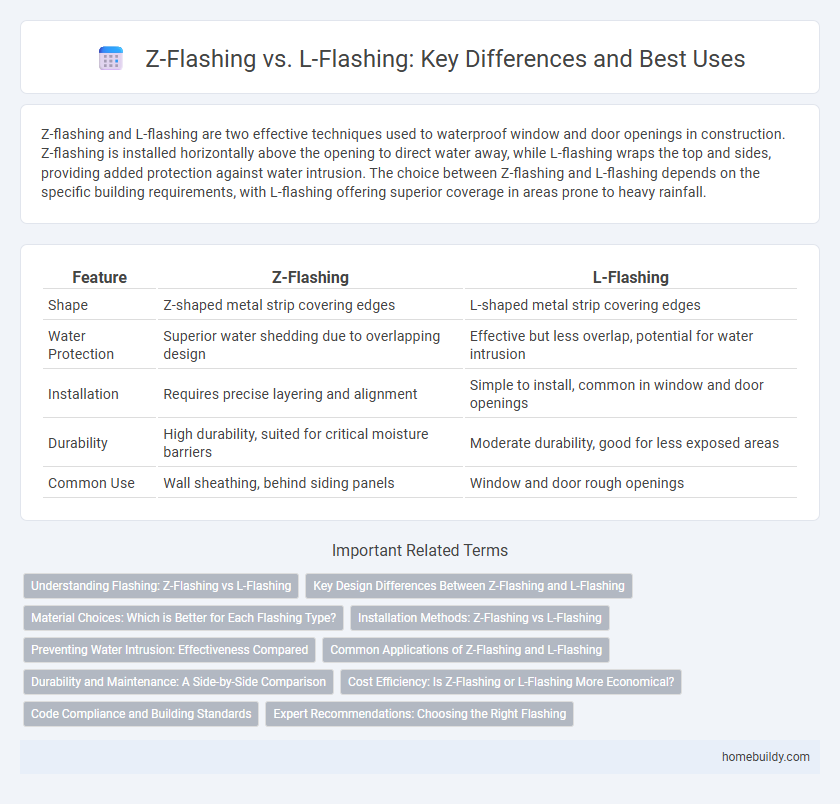Z-flashing and L-flashing are two effective techniques used to waterproof window and door openings in construction. Z-flashing is installed horizontally above the opening to direct water away, while L-flashing wraps the top and sides, providing added protection against water intrusion. The choice between Z-flashing and L-flashing depends on the specific building requirements, with L-flashing offering superior coverage in areas prone to heavy rainfall.
Table of Comparison
| Feature | Z-Flashing | L-Flashing |
|---|---|---|
| Shape | Z-shaped metal strip covering edges | L-shaped metal strip covering edges |
| Water Protection | Superior water shedding due to overlapping design | Effective but less overlap, potential for water intrusion |
| Installation | Requires precise layering and alignment | Simple to install, common in window and door openings |
| Durability | High durability, suited for critical moisture barriers | Moderate durability, good for less exposed areas |
| Common Use | Wall sheathing, behind siding panels | Window and door rough openings |
Understanding Flashing: Z-Flashing vs L-Flashing
Z-flashing and L-flashing are essential flashing techniques used to prevent water infiltration around windows and doors. Z-flashing is typically installed horizontally, overlapping siding panels to direct water away from the structure, while L-flashing is shaped like an "L" and is used primarily at vertical edges to seal joints and corners. Proper installation of Z-flashing and L-flashing ensures effective moisture management, enhancing the durability and energy efficiency of building envelopes.
Key Design Differences Between Z-Flashing and L-Flashing
Z-flashing features a continuous, overlapping metal or vinyl strip shaped like the letter "Z," designed to direct water away from wall openings, ensuring superior moisture protection. L-flashing, shaped like the letter "L," typically seals the top edge of windows or doors and relies on additional components to prevent water intrusion. Key design differences include Z-flashing's integrated drip edge and full coverage approach versus L-flashing's simpler profile requiring extra sealing measures.
Material Choices: Which is Better for Each Flashing Type?
Z-flashing typically uses aluminum or vinyl, offering superior durability and resistance to moisture, ideal for siding applications where water needs to be deflected efficiently. L-flashing, often made from galvanized steel or aluminum, provides strong edge protection and is preferred for window and door flashing due to its ability to fit snugly and create tight seals. Material choice impacts performance: aluminum excels in corrosion resistance for Z-flashing, while galvanized steel's rigidity benefits L-flashing in structural integrity.
Installation Methods: Z-Flashing vs L-Flashing
Z-flashing is installed by overlapping horizontal shingle edges to direct water away from wall openings, creating a continuous barrier against moisture intrusion. L-flashing wraps both the horizontal surface and the adjoining vertical face of a structure, providing enhanced protection at roof-to-wall intersections by sealing joints more thoroughly. Choosing between Z-flashing and L-flashing depends on the specific architectural features and the required level of water resistance in the installation area.
Preventing Water Intrusion: Effectiveness Compared
Z-flashing outperforms L-flashing in preventing water intrusion by providing a continuous barrier that redirects water away from vulnerable joints and openings more effectively. Its interlocking design minimizes gaps where moisture can penetrate, enhancing the durability of exterior cladding systems. Studies show Z-flashing reduces the risk of water damage and mold growth compared to L-flashing, making it a superior choice for moisture control in building envelopes.
Common Applications of Z-Flashing and L-Flashing
Z-flashing is commonly used in exterior wall assemblies to prevent water intrusion at horizontal joints, especially where different materials meet, such as between siding and windows or doors. L-flashing, often installed at vertical joints and edges, is ideal for window jambs and door frames to redirect water away from openings. Both flashing types enhance building envelope integrity by effectively managing moisture, but Z-flashing is preferred for horizontal seams while L-flashing suits vertical edges.
Durability and Maintenance: A Side-by-Side Comparison
Z-flashing provides superior durability compared to L-flashing by effectively channeling water away from vulnerable joints, reducing the risk of water infiltration and structural damage. Maintenance of Z-flashing is generally easier, as its design minimizes debris accumulation and requires less frequent inspection or replacement. In contrast, L-flashing often needs more maintenance due to its shape, which can trap moisture and debris, leading to quicker deterioration over time.
Cost Efficiency: Is Z-Flashing or L-Flashing More Economical?
Z-flashing generally offers greater cost efficiency than L-flashing due to its simpler installation process and reduced labor time, lowering overall expenses on exterior wall projects. While L-flashing provides enhanced water barrier performance, its more complex design and installation can increase material and labor costs. Contractors seeking budget-friendly solutions often prefer Z-flashing for its balance of weather protection and economic advantages.
Code Compliance and Building Standards
Z-flashing provides superior water management by directing moisture away from building envelopes, ensuring better compliance with International Building Code (IBC) requirements for moisture protection. Unlike L-flashing, Z-flashing creates a continuous barrier that reduces the risk of water intrusion, which meets the standards set by ASTM E2112 for exterior wall assemblies. Building officials often favor Z-flashing for its enhanced durability and effectiveness in preventing mold and structural damage, aligning with LEED certification criteria.
Expert Recommendations: Choosing the Right Flashing
Experts recommend selecting Z-flashing over L-flashing for superior moisture management in wall assemblies, especially in areas prone to heavy rainfall or extensive siding exposure. Z-flashing provides enhanced water shedding by covering both the top and sides of the joint, reducing the risk of water infiltration compared to L-flashing, which only covers one side. Professional builders emphasize the importance of proper installation techniques and material compatibility to maximize the effectiveness of Z-flashing in preventing moisture damage.
Z-flashing vs L-flashing Infographic

 homebuildy.com
homebuildy.com